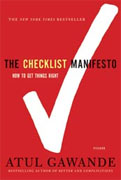The Checklist Manifesto
Atul Gawande
book reviews:
· general fiction
· chick lit/romance
· sci-fi/fantasy
· graphic novels
· nonfiction
· audio books
· author interviews
· children's books @
curledupkids.com
· DVD reviews @
curledupdvd.com
newsletter
win books
buy online
links
home
for authors
& publishers
for reviewers

 |
The Checklist Manifesto: How to Get Things Right Atul Gawande Picador Paperback 240 pages January 2011 |
|
Whether it is in aviation or in building construction or in surgery, many of the tasks that professionals undertake on a fairly routine basis are not only time-consuming; they are also complex, perhaps irreducibly so. Therefore, when performing such tasks, even talented and dedicated professionals can make unwitting errors which may turn out to have disastrous consequences. Given this state of affairs, what simple—but not simplistic—steps can one take to minimize, if not altogether eliminate, these putatively calamitous errors? The purpose of this book is to shed light on this salient question.
The answer, claims the author, lies in creating and then actually using simple but goal-oriented checklists. He gives examples from many different practical settings to buttress his claim that since many tasks across different professions today are complicated, specialization is necessary. Even so, specialization alone will not get many of the more complex tasks done without errors. For this to happen, what is needed is a “succession of day-by-day checks that guide how [a complex task is to be carried out] and ensure that the knowledge of hundreds, perhaps thousands, is put to use in the right place at the right time in the right way” (p. 62). Using the example of the now well-known ill effects of Hurricane Katrina in New Orleans, the author rightly contends that under conditions of true complexity, by which he means situations where “the knowledge required exceeds that of any individual and unpredictability reigns” (p.78), attempts to dictate every step from some centralized facility are bound to fail. This is because in such circumstances, people need room not only to act but also to adapt to rapidly changing conditions. The key point to note, claims the author, is that these are also the circumstances in which “not only are checklists a help, [but] they are required for success” (p. 78, emphasis in original). Addressing the question of the design of checklists, the author points out that there are both good and bad checklists. “Bad checklists are vague and imprecise” (p. 120). In contrast, good checklists are “efficient, to the point, and easy to use even in the most difficult situations” (p. 120). We are told that when performing a complex task with a good checklist, the underlying task is made more straightforward because good checklists provide reminders of only the most critical and important steps. In other words, good checklists are quick and simple tools whose primary purpose is to buttress the skills of expert professionals. So far so good, but it is certainly possible to take issue with the author’s unsubstantiated claim that “we rarely investigate our failures” (p. 132). In fact, at least in the United States, significant resources are devoted to studying our failures. For instance, the raison d’etre of the National Transportation Safety Board (NTSB) is to analyze our transportation-related failures and to recommend improvements for the future. The basic point of this book is simple to grasp, and it has already been made by the author in an article in the New Yorker. Given the existence of this article, the incremental contribution of this book is not copious. Also, both formal and informal checklists are used by all kinds of individuals a lot more in contemporary times than the author acknowledges, and the author pays little attention to how checklists might actually be implemented outside the field of medicine. The above caveats notwithstanding, it should be noted that this is an easy-to-read book that provides many informative examples and tells lucid stories to support its basic contention that checklists can be and frequently have been very useful aids to competent professionals performing complex tasks in difficult circumstances. Originally published on Curled Up With A Good Book at www.curledup.com. © Amitrajeet A. Batabyal, 2011 |
| Also by Atul Gawande: |
|
|
|
 Click here to learn more about this month's sponsor! |
|
| fiction · sf/f · comic books · nonfiction · audio newsletter · free book contest · buy books online review index · links · · authors & publishers reviewers |
|
| site by ELBO Computing Resources, Inc. | |
 The author begins the proceedings by commenting on the problem of extreme complexity. Focusing on the treatment of patients in intensive care, he notes that intensive care succeeds only when one holds the odds of doing harm low enough for the odds of doing good to prevail. In addition, we are told that the reality of intensive care is that at any point in time, one is “as apt to harm as [one is] to heal” (p. 27). This leads the author pose two general questions concerning medical care. First, what does one do in situations where expertise alone is insufficient? Second, what does one do when even the so-called “super specialists” fail?
The author begins the proceedings by commenting on the problem of extreme complexity. Focusing on the treatment of patients in intensive care, he notes that intensive care succeeds only when one holds the odds of doing harm low enough for the odds of doing good to prevail. In addition, we are told that the reality of intensive care is that at any point in time, one is “as apt to harm as [one is] to heal” (p. 27). This leads the author pose two general questions concerning medical care. First, what does one do in situations where expertise alone is insufficient? Second, what does one do when even the so-called “super specialists” fail?